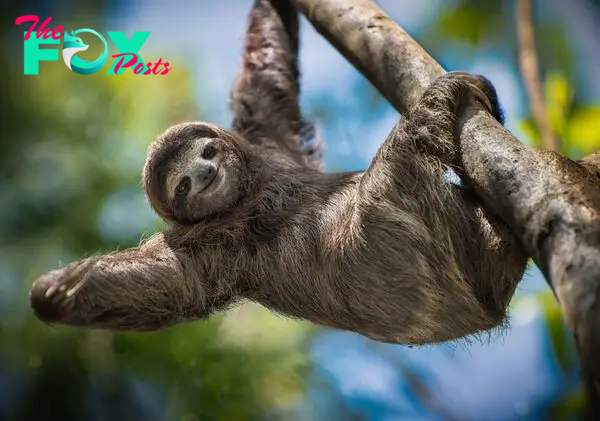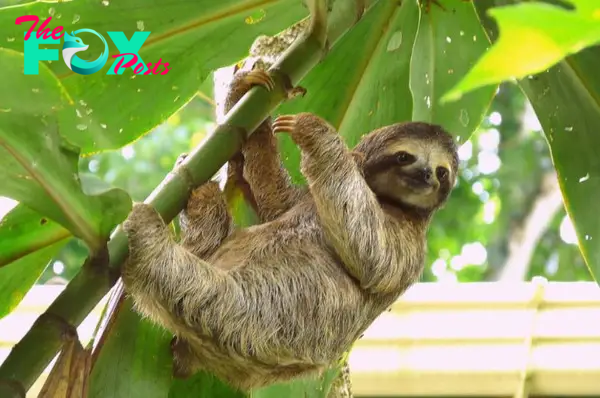One of the most striking features of sloths is their slow movement. They move at an average speed of about 0.24 kilometers per hour, making them one of the slowest animals on the planet. This sluggish pace is due to their low metabolic rate, a characteristic that helps them conserve energy in the dense, nutrient-poor environments of their rainforest homes.
Sloths are divided into two main categories: two-toed and three-toed sloths. Despite their similar names, these groups are not closely related and differ significantly in terms of anatomy and behavior. Two-toed sloths belong to the family Megalonychidae, while three-toed sloths are part of the family Bradypodidae. This divergence in evolutionary paths is a testament to the diversity of life in the rainforests.
One of the most fascinating aspects of sloth biology is their symbiotic relationship with algae and insects. The fur of a sloth is a mini-ecosystem in itself, often hosting a variety of moths, beetles, and fungi. The greenish hue of their fur is due to the presence of algae, which helps them blend into their surroundings and provides additional camouflage from predators.

Sloths spend the majority of their lives hanging upside down in the trees. Their long, curved claws are perfectly adapted for gripping branches, allowing them to maintain a secure hold even when they are fast asleep. This upside-down lifestyle also aids in digestion, as gravity helps move food through their digestive system more efficiently.
Their diet primarily consists of leaves, fruits, and flowers, which are low in calories and nutrients. This diet is one reason for their slow metabolism. To compensate for the low nutritional value of their food, sloths have a multi-chambered stomach that slowly ferments the plant matter, allowing them to extract as many nutrients as possible.
Despite their slow pace on land, sloths are surprisingly good swimmers. They can move three times faster in water than on land, using their long arms to propel themselves through rivers and streams. This ability is crucial for survival, as it allows them to cross bodies of water to find new feeding grounds or escape from predators.
Speaking of predators, sloths face a number of natural threats, including jaguars, eagles, and snakes. Their slow movements and excellent camouflage provide some protection, but they are still vulnerable when they descend to the ground, which they do about once a week to defecate. This is often the most dangerous time for a sloth, as they are more exposed to predators.
Reproduction in sloths is a slow process as well. Female sloths typically give birth to one baby at a time after a gestation period of six months. The baby sloth clings to its mother’s belly for the first few months of its life, learning to navigate the treetops and find food. This close bond between mother and baby is crucial for the youngster’s survival in the challenging environment of the rainforest.

Sloths have also captured the interest of scientists due to their unique physiology. For instance, their unusually low body temperature, which can range between 30 to 34 degrees Celsius, is one of the lowest among mammals. This trait is another adaptation to their low-energy diet, allowing them to conserve even more energy.
The slow Lifestyle of sloths extends to their sleep patterns as well. They can sleep up to 15 to 20 hours a day, although recent studies have shown that wild sloths may sleep less than their captive counterparts. This extensive rest period is essential for conserving energy and digesting their fibrous diet.
Conservation efforts are increasingly important for sloths as their rainforest habitats face deforestation and fragmentation. Organizations around the world are working to protect these unique animals by preserving their natural habitats and raising awareness about the importance of biodiversity.
Sloths also play a crucial role in their ecosystems. By feeding on leaves and fruits, they help to shape the vegetation structure of the rainforest. Their slow movements and defecation patterns aid in seed dispersal, contributing to the Health and diversity of the forest.
Cultural depictions of sloths have contributed to their popularity. Often portrayed as the epitome of laziness, these animals have become symbols of relaxation and a slower pace of life. This perception has made them beloved characters in movies, books, and even as internet memes.

However, it’s important to understand that sloths are not simply lazy. Their slow movements are a highly evolved survival strategy that has allowed them to thrive in a challenging environment. By moving slowly, they avoid detection by predators and conserve energy, which is crucial for their survival on a diet of low-calorie leaves.
Interestingly, sloths have an unusual respiratory system. They have fewer ribs than most mammals, which allows their lungs to expand more efficiently when they are hanging upside down. This adaptation is another example of how these animals have evolved to fit their unique niche in the ecosystem.
The evolution of sloths is a story of remarkable adaptation and survival. Fossil records show that ancient sloths were much larger than their modern relatives. Some prehistoric sloths, like the Megatherium, were as large as elephants and roamed the ground rather than the trees. The shift to an arboreal Lifestyle allowed sloths to exploit new ecological niches and avoid comPetition with other large herbivores.
Sloths communicate primarily through vocalizations and scent markings. Although they are generally solitary animals, they do occasionally interact with each other. Their vocalizations include high-pitched squeaks and low-pitched groans, which can be used to signal distress or attract mates.
The study of sloths has also provided insights into the broader field of animal physiology and behavior. Researchers have learned about the importance of metabolic rates, thermoregulation, and the role of symbiotic relationships in animal survival. These findings have implications for understanding other slow-moving animals and the ecosystems they inhabit.
In recent years, sloths have become ambassadors for conservation efforts. Their charismatic appearance and unique lifestyle have made them popular subjects for documentaries and educational programs. By raising awareness about sloths, conservationists hope to highlight the broader issues facing tropical rainforests and the need to protect these vital ecosystems.

Ecotourism has also played a role in sloth conservation. Responsible tourism initiatives in countries like Costa Rica and Panama allow visitors to observe sloths in their natural habitats while supporting local conservation efforts. These programs provide economic incentives for preserving rainforests and promote sustainable practices.
Despite their popularity, sloths face numerous threats from human activities. Habitat destruction, climate change, and illegal wildlife trade are significant challenges that require ongoing attention and action. Protecting sloths means not only safeguarding individual animals but also preserving the intricate web of life in which they are a crucial part.
Sloths continue to captivate and inspire people around the world. Their slow, deliberate movements and gentle demeanor remind us of the value of patience and the beauty of taking life at a slower pace. As we learn more about these remarkable Animals, we gain a deeper appreciation for the diversity of life on Earth and the importance of conserving it for future generations.
In summary, sloths are much more than their reputation for laziness suggests. They are highly adapted, fascinating creatures with complex behaviors and ecological roles. From their slow metabolism and symbiotic relationships to their role in seed dispersal and forest health, sloths offer a unique perspective on the interconnectedness of life. Their continued survival depends on our efforts to protect their habitats and promote sustainable practices. By doing so, we ensure that future generations can enjoy the wonder and beauty of these remarkable animals.


 Animals3w ago
Animals3w ago
 Animals3w ago
Animals3w ago
 Animals3w ago
Animals3w ago
 Animals3w ago
Animals3w ago
 Animals3w ago
Animals3w ago
 Animals3w ago
Animals3w ago
 Animals3w ago
Animals3w ago
 Animals3w ago
Animals3w ago



























